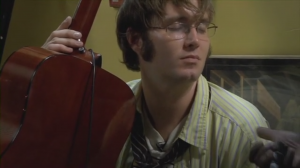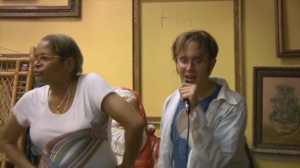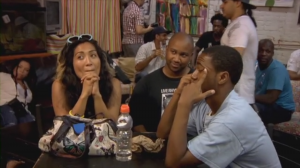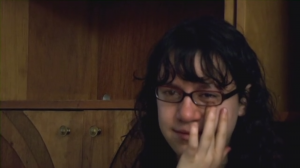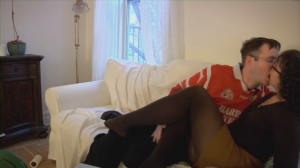
Inside Llewyn Davis made many critics’ top ten lists this year, and a lot of people are rooting for the film this awards season. I’m not one of them. I see enough movies that one more about a white guy (Oscar Isaac, who plays the eponymous role, is Latino, but the script makes sure to establish the character is white) who is also an “asshole” as Carey Mulligan (unrecognizable in long, black, Beatnik hair and bangs: she plays fellow folksinger Jean) hisses throughout the film, should not faze me. The songs and their performances are as pretty and forgettable as the presence of Justin Timberlake, again foisted on an indifferent movie-going public, this time playing Jean’s husband and musical partner Jim. So why did this film piss me off so much?
Llewyn Davis and most of the folk performers he sees and interacts with are white guys (Mulligan is one of two women we see onstage. Davis heckles the second.) We see two people of color in the film: an African American man, who is asked to clean up shit in a nursing home (really) and an Asian American woman who is the butt of the joke at a dinner party. In most mainstream films we’ve become so inured to seeing the world through white-guy (asshole or not) eyes that we’ve mistaken their stories for the “true” and “real” stories of the time. But in 1961, when the film takes place, the rising superstar on the folk coffeehouse scene was a young Latina named Joan Baez, whose own fame gave a boost to the career of her-then boyfriend Bob Dylan (whose character has a cameo appearance toward the end of the film).
[youtube_sc url=”http://www.youtube.com/watch?v=4Xlmb8gG7HU” title=”Joan%20Baez%20%22Silver%20Dagger%22″ autohide=”0″]
Baez wasn’t an anomaly. Martin Luther King called Odetta “the queen of American folk music” when she, along with Baez, played at The March On Washington in 1963. The following song is from a live album Odetta recorded in Carnegie Hall just before the time the events of the film take place.
[youtube_sc url=”http://www.youtube.com/watch?v=6iZj6P-bkcY” title=”Odetta%20%22Sometimes%20I%20Feel%20Like%20A%20Motherless%20Child%22″ autohide=”0″]
In a year that has seen a breakthrough of African American directors making films about African Americans, some prominent Black writers have expressed discomfort with the stream of movies that show Black people being tortured and killed instead of just living their lives. Editing people of color out of a history, like that of Greenwich Village folk scene in the 1960s, in which they had a prominent role, but were neither tortured nor killed, does not help this problem.
I don’t expect strict historical accuracy from a period film, but I would like it to at least resemble the place and time it depicts– and in more than just its album covers, clothes and hazy, smoke-filled interiors. As the adage about musical theater goes, “the audience doesn’t go out humming the scenery.” The absence in the film of performers of color belies the history of folk music in New York City, where in the decades before the sixties, performers like Josh White and Lead Belly popularized the genre.
[youtube_sc url=”http://www.youtube.com/watch?v=lCiJ4QQG9WQ ” autohide=”0″]
Those performers didn’t just introduce the songs to the public, they directly influenced the performers who came after them: Pete Seeger gave credit to Lead Belly for his guitar playing style, which he then taught on record to fledgling folkies. Dave Van Ronk, whose posthumously published autobiography provides the loose basis for the script also cited gospel and blues as his musical inspiration. That influence is apparent in Van Ronk’s songs, which are a world away from the whiter-than white, radio-ready music we hear in the film. Oscar Isaac, who was a musician before he was an actor (he sings and plays well and has a striking screen presence in spite of the script) has said in interviews that his own style is more blues-influenced but that the filmmakers (and the music producer of the film, T Bone Burnett, who previously worked with the Coen brothers on the hit soundtrack for O Brother, Where Art Thou) wanted the music to take a different direction.
[youtube_sc url=”http://www.youtube.com/watch?v=754sRFIHIrA” title=”Dave%20Van%20Ronk%20%22He%20Was%20A%20Friend%20Of%20Mine%22″ autohide=”0″]
Perhaps in part because of the African American influence even white folk performers from the coffeehouse scene were outspoken supporters of civil rights and other “progressive” (at the time) causes. The March On Washington featured not just Baez and Odetta, but Bob Dylan and Peter, Paul and Mary. The civil rights movement for many young people (including, most famously, Dylan and Baez) led to the antiwar movement, which then, for many women, led to the feminist movement. Perhaps the most infuriating thing about Inside Llewyn Davis is how rabidly (and anachronistically) apolitical it is. Because Black people barely exist in its universe, no one concerns themselves with civil rights. Even though one of the folk performers is a soldier in uniform who hitchhikes from his base every weekend to perform in the coffeehouses (the character is based on singer-songwriter Tom Paxton), no one (except that character himself) is antiwar.
The song from the film most likely to stay with audience members (for better or worse) is “Please Mr. Kennedy” in which the singer pleads that he doesn’t want to go “to outer space”. The song it’s based on is a doo-wop record released in 1962 in which the singer asks that Kennedy not send him to Vietnam.
[youtube_sc url=”http://www.youtube.com/watch?v=DW6lQKLn5B8″ title=”Mickey%20Woods%20%22Please%20Mr.%20Kennedy%22%20″ autohide=”0″]
In its portrayal of the women on the folk scene, the film borders on science fiction. Jean tells Llewyn that she would like to have a baby with Jim and move to the suburbs when any number of women, (like Joyce Johnson and Hettie Jones) who were in Greenwich Village at the time have written in detail that they (and the other women they knew) went to Greenwich Village to escape conventional, suburban family life. Had the Coen brothers bothered to read any accounts from women who had abortions when the procedure was still against the law, they would, as Van Ronk’s ex-wife Terri Thal’s excellent counterpoint notes, not have portrayed abortion as a matter-of-fact sideline for a licensed OB-GYN with a nice, clean, airy office and waiting room. As if the film weren’t dismissive enough of women performers, the script also posits that Jean has to fuck a sleazy club owner to get a gig, which Thal calls bullshit and I call misogyny– since it presents as fact the oldest dismissal of any woman’s accomplishments: “She slept her way to the top.”
Films like Llewyn Davis make me particularly grateful for documentaries. Sini Anderson’s The Punk Singer (disclaimer: I know Anderson slightly and produced one of her shows when she was with Sister Spit in the ’90s) is all about music and politics: feminism and women, while focusing on one person, Kathleen Hanna, formerly of the bands Bikini Kill, Le Tigre and current front-woman of The Julie Ruin.

The film spotlights the neglected history of the Riot Grrrl movement through Hanna’s trajectory. We see through interviews and video of live performances, what Hanna’s music meant to her fans (the best of these interviews are with other musicians like Corin Tucker of Sleater-Kinney and Beastie Boy Adam Horovitz, Hanna’s husband, who gushes about her work in the way every artist wants her partner to) and to the culture. As someone who was not eighteen when Bikini Kill were on the scene I never saw them live, but the clips in the film are electrifying. Hanna is every bit the badass the fans remember, whether she is singing and dancing her way across the stage wearing a skimpy top and “Slut” written across her abdomen or when she commands rowdy young men in the audience (or as she calls them “fuckers”) to stand in the back so women can be safe in the front (or even sit on the stage to escape harm). At that time post-punk shows were an excellent place to get a head-injury: I remember the band L7 had to stop playing and the house lights in the club went up while we in the audience waited for an ambulance to come for someone who fell (or was hit) while crowd-surfing.

Every movement likes to think of itself as completely original, and Riot Grrrl is no different, but I would have liked to see and hear more about Hanna’s feminist musical influences and antecedents. I was eighteen during the first wave of post-punk bands and remember well that many of them (and the original punk bands) included women: Siouxsie Sioux, Poly Styrene, Penelope Houston, Pauline Black, hell, even the Go-Go’s started as a punk band. And some of those artists were unequivocal feminists: Styrene said she would shave her head if one more journalist called her a “sex symbol” and then followed through. The post punk Au Pairs were singing about feminist issues a good decade before the Riot Grrrl scene.
[youtube_sc url=”http://www.youtube.com/watch?v=WaiXfdYCZCw” title=”Au%20Pairs%20%22It%27s%20Obvious%22″ autohide=”0″]
Hanna wrote compellingly about Styrene when she died and what I missed most in the film was Hanna’s voice as a writer (rather than an interview subject). Hanna began as a spoken-word artist, so maybe she wouldn’t have been listening to most of the music I’ve listed, though she must have heard, and was perhaps influenced by that other spoken-word artist turned singer: Patti Smith.
The film includes a video of a feminist community meeting Bikini Kill holds when they move from Olympia, Washington to Washington D.C. and we see the only two Black women (besides a gratuitous inclusion of a Rebecca Walker Third Wave feminism clip) in the film, which reminds us that the problems white feminists have in making room for Black women and intersectionality have been with us for a while now.
I was a fan of the band Hanna formed after Bikini Kill broke up, Le Tigre, and Hanna’s description of their songs as music they would make if “everything were great” rings true. I saw them live very early on, when Sadie Benning was still part of the trio, before JD Samson joined: the film never mentions Benning, even though she was a founding member. Hanna had a long intro to one of the songs that instead of being the embarrassing ramble I expected was a sweet story about the neighbors who made her feel safe during her troubled childhood. Perhaps Hanna’s between-song patter is how she keeps in touch with her spoken-word roots.
I also wish the film addressed Le Tigre’s participation in The Michigan Womyn’s Music Festival, which many in the queer community and beyond have boycotted for years because the Fest excludes trans women. The band members’ silence on the issue isn’t consistent with their message of inclusion.
After years of chronic illness Hanna has started another band The Julie Ruin (whom we see perform in the last scene of the film). They just released a new record, and even though it’s front-woman is now 45, their songs are some of the best things I’ve heard on college radio. Viva The Punk Singer !
[youtube_sc url=”http://www.youtube.com/watch?v=fwrXC5OXqgc” title=”%27The%20Punk%20Singer%27%20Trailer”]
See also at Bitch Flicks: The Punk Singer and a Room of Her–and Our–Own, by Leigh Kolb
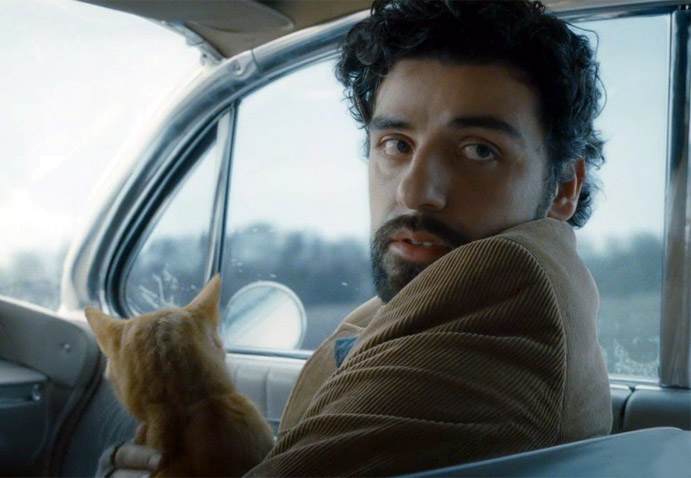

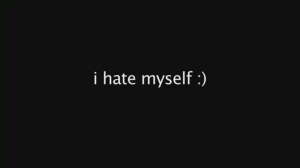
 title card.
title card.